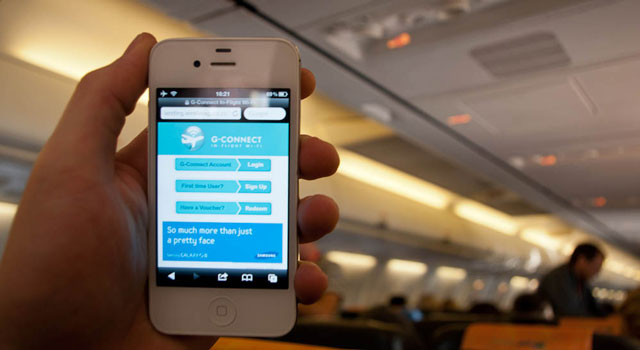
Internet service provider WirelessG, airline Mango and mobile operator Vodacom conducted a test flight on Tuesday to showcase the first in-flight Wi-Fi service in SA.
Unfortunately, putting 115 people with multiple devices and the desire to test the service to its limit on one plane proved too much for the service, with only about 30% of those on board being able to connect.
The connectivity for the in-flight Wi-Fi service is supplied using an 8Mbit/s connection provided by cellular network Vodacom and WirelessG using a Ku-band satellite. It’s being rolled out across Mango’s fleet of five new Boeing 737-800s.
The service is compatible with most Wi-Fi-enabled devices, including smartphones, tablets and laptops.
There are three packages on offer. One-way access costs R50 per single-sector flight; a one-day pass — valid for 20 hours — costs R90, irrespective of the number of flights completed during the period. A per-minute option, billed through a G-Connect online account, offers in-flight and on-the-ground Wi-Fi at R1/minute.
All three packages offer unlimited data use during the allotted time.
An air-to-land SMS service will also be available, managed through a Web service.
With most participants on the test flight trying to connect multiple devices simultaneously, the onboard gateway was unable to meet the demand. WirelessG CEO Carel van der Merwe says 115 people trying to connect even more devices exceeded the gateway’s abilities.
In WirelessG’s defence, the circumstances of the test flight don’t mirror likely real-world usage. During the test flight, those who managed to connect saw ping times well above 1 000ms, with the longest consistent string of pings being 120 packets.
Radio presenter Aki Anastasiou managed to make a Skype call early on in the flight and says the call quality was excellent. However, the call dropped.

The service will be monitored continually with real-time support available to users during flights. Data-intensive services such as YouTube and peer-to-peer downloads will, however, not be allowed.
“This is done to ensure the quality of the service remains unimpeded,” says Van der Merwe. “We already have plans in place to expand the G-Connect In-Flight Wi-Fi product offering further in a second phase, where we aim to include IPTV and other entertainment services.”
Users will also be unable to connect to adult content sites — for obvious reasons.
The in-flight Wi-Fi service is expected to be operational on 80% of Mango’s fleet by the end of June. — (c) 2012 NewsCentral Media




